Nanosecond Laser Ablation of Ti–6Al–4V under Different Temperature
Abstract
:1. Introduction
2. Experimental Materials and Methods
3. Results and Analysis
3.1. Ablation Analysis of Experiment A
3.2. Ablation Analysis of Experiment B
4. Conclusions
- In both experiments (1. laser fluence 0.1429 μJ/μm2, 50 pulses; 2. laser fluence 0.7143 μJ/μm2, 32 pulsed), with the increasing of substrate temperature, the ablation craters’ diameter increased and showed a Gaussian distribution. In addition, at pulsed laser fluence of 0.7143 μJ/μm2, with the increase of pulse number, diameter increased rapidly first and then slowed down; its final diameter was larger than the diameter at laser fluence of 0.1429 μJ/μm2;
- In both experiments, with the increasing of substrate temperature, the ablation-crater depth decreased. In addition, at pulsed-laser fluence of 0.7143 μJ/μm2, with the increase of pulse number, depth change was close to linear growth the higher the substrate temperature was, the slower the deep ablation was and its final depth was lower than the depth at pulsed laser fluence of 0.1429 μJ/μm2.
- In both experiments, with the increasing of substrate temperature, ablation efficiency ω showed a trend of rising first and then declining. In addition, at pulsed-laser fluence of 0.1429 μJ/μm2, ω rise rapidly when substrate temperature higher than 150 °C and decline rapidly at 350 °C; At pulsed laser fluence of 0.7143 μJ/μm2, ω rise rapidly when substrate temperature higher than 100 °C and declined rapidly at 350 °C. ω could approximately presented the volume ablation per unit laser energy and could be consistent with the existing theories.
Author Contributions
Funding
Conflicts of Interest
References
- Böhme, R.; Pissadakis, S.; Ruthe, D.; Zimmer, K. Laser backside etching of fused silica with ultra-short pulses. Appl. Phys. A 2006, 85, 75–78. [Google Scholar] [CrossRef]
- Weck, A.; Crawford, T.; Wilkinson, D.; Haugen, H.K.; Preston, J.S. Laser drilling of high aspect ratio holes in copper with femtosecond, picosecond and nanosecond pulses. Appl. Phys. A 2008, 90, 537–543. [Google Scholar] [CrossRef]
- Manninen, M.; Hirvimäki, M.; Matilainen, V.-P.; Salminen, A. Comparison of Laser-Engraved Hole Properties between Cold-Rolled and Laser Additive Manufactured Stainless Steel Sheets. Appl. Sci. 2017, 7, 913. [Google Scholar] [CrossRef] [Green Version]
- Abdellaoui, N.; Pillonnet, A.; Berndt, J.; Boulmer-Leborgne, C.; Kovacevic, E.; Moine, B.; Penuelas, J.; Pereira, A. Growth process of nanosized aluminum thin films by pulsed laser deposition for fluorescence enhancement. Nanotechnology 2015, 26, 11. [Google Scholar] [CrossRef]
- Bulgakova, N.; Bulgakov, A. Pulsed laser ablation of solids: Transition from normal vaporization to phase explosion. Appl. Phys. A 2001, 3, 199–208. [Google Scholar] [CrossRef]
- Fishburn, J.M.; Withford, M.J.; Coutts, D.W.; Piper, J.A. Study of the fluence dependent interplay between laser induced material removal mechanisms in metals: Vaporization, melt displacement and melt ejection. Appl. Surf. Sci. 2006, 252, 5182–5188. [Google Scholar] [CrossRef]
- Chichkov, B.N.; Momma, C.; Nolte, S.; Von Alvensleben, F.; Tünnermann, A. Femtosecond, picosecond and nanosecond laser ablation of solids. Appl. Phys. A 1996, 63, 109–115. [Google Scholar] [CrossRef]
- Martynenko, Y.V. Metal droplet erosion and shielding plasma layer under plasma flows typical of transient processes in tokamaks. Plasma Phys. Rep. 2017, 43, 324–329. [Google Scholar] [CrossRef]
- Porneala, C.; Willis, D.A. Observation of nanosecond laser-induced phase explosion in aluminum. Appl. Phys. Lett. 2006, 89, 211121. [Google Scholar] [CrossRef]
- Gragossian, A.; Tavassoli, S.H.; Shokri, B. Laser ablation of aluminum from normal evaporation to phase explosion. J. Appl. Phys. 2009, 105, 103304. [Google Scholar] [CrossRef]
- Abdelmalek, A.; Bedrane, Z.; Amara, E.-H.; Sotillo, B.; Bharadwaj, V.; Ramponi, R.; Eaton, S.M. Ablation of Copper Metal Films by Femtosecond Laser Multipulse Irradiation. Appl. Sci. 2018, 8, 1826. [Google Scholar] [CrossRef] [Green Version]
- Yan, Z.X.; Mei, X.S.; Wang, W.J.; Pan, A.F.; Lin, Q.Y.; Huang, C.C. Numerical simulation on nanosecond laser ablation of titanium considering plasma shield and evaporation-affected surface thermocapillary convection. Opt. Commun. 2019, 453, 124384. [Google Scholar] [CrossRef]
- Cao, Y.F.; Zhao, X.; Shin, Y.C. Analysis of nanosecond laser ablation of aluminum with and without phase explosion in air and water. J. Laser Appl. 2013, 25, 032002. [Google Scholar] [CrossRef]
- Elsied, A.M.; Dieffenbach, P.C.; Diwakar, P.K.; Hassanein, A. Nanosecond laser-metal ablation at different ambient conditions. Spectrochim. Acta B 2018, 143, 26–31. [Google Scholar] [CrossRef]
- Kononenko, T.V.; Garnov, S.V.; Klimentov, S.M.; Konov, V.I.; Loubnin, E.N.; Dausinger, F.; Raiber, A.; Taut, C. Laser ablation of metals and ceramics in picosecond-nanosecond pulsewidth in the presence of different ambient atmospheres. Appl. Surf. Sci. 1997, 109–110, 48–51. [Google Scholar] [CrossRef]
- Benavides, O.; May, L.D.; Mejia, E.B.; Hernandez, J.A.R.; Gil, A.F. Laser wavelength effect on nanosecond laser light reflection in ablation of metals. Laser Phys. 2016, 26, 12. [Google Scholar] [CrossRef]
- Geetha, M.; Singh, A.K.; Asokamani, R.; Gogia, A.K. Ti based biomaterials, the ultimate choice for orthopaedic implants—A review. Prog. Mater. Sci. 2009, 54, 397–425. [Google Scholar] [CrossRef]
- Boyer, R.R. An overview on the use of titanium in the aerospace industry Mat. Sci. Eng. A 1996, 213, 103–114. [Google Scholar] [CrossRef]
- Gurrappa, I. Characterization of titanium alloy Ti-6Al-4V for chemical, marine and industrial applications. Mater. Charact. 2003, 51, 131–139. [Google Scholar] [CrossRef]
- Naka, S. Advanced titanium-based alloys. Curr. Opin. Solid State Mater. Sci. 1996, 1, 333–339. [Google Scholar] [CrossRef]
- Yu, J.; Zhang, D.Q.; Li, H.; Song, C.H.; Zhou, X.; Shen, S.N.; Zhang, G.Q.; Yang, Y.Q.; Wang, H.Z. Detection of Internal Holes in Additive Manufactured Ti-6Al-4V Part Using Laser Ultrasonic Testing. Appl. Sci. 2020, 10, 365. [Google Scholar] [CrossRef] [Green Version]
- Wang, W.J.; Mei, X.S.; Jiang, G.D.; Lei, S.T.; Yang, C.J. Effect of two typical focus positions on microstructure shape and morphology in femtosecond laser multi-pulse ablation of metals. Appl. Surf. Sci. 2008, 255, 2303–2311. [Google Scholar] [CrossRef]
- Li, F.; Chen, X.G.; Lin, W.H.; Pan, H.; Jin, X.; Hua, X.M. Nanosecond laser ablation of Al-Si coating on boron steel. Surf. Coat. Technol. 2017, 319, 129–135. [Google Scholar] [CrossRef]
- Vadillo, J.M.; Fernández Romero, J.M.; Rodriguez, C.; Laserna, J.J. Effect of plasma shielding on laser ablation rate of pure metals at reduced pressure. Surf. Interface Anal. 1999, 27, 1009–1015. [Google Scholar] [CrossRef]
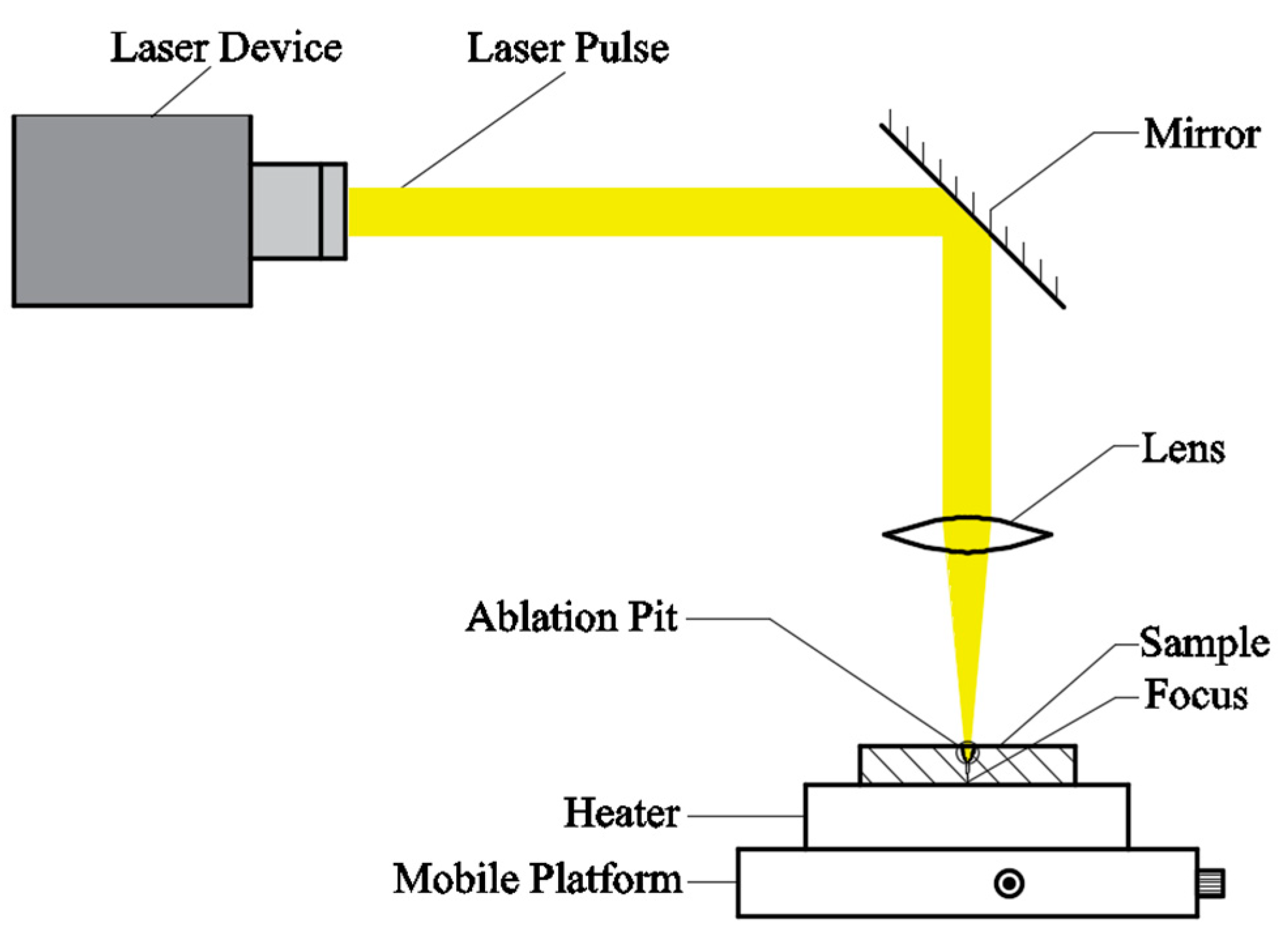
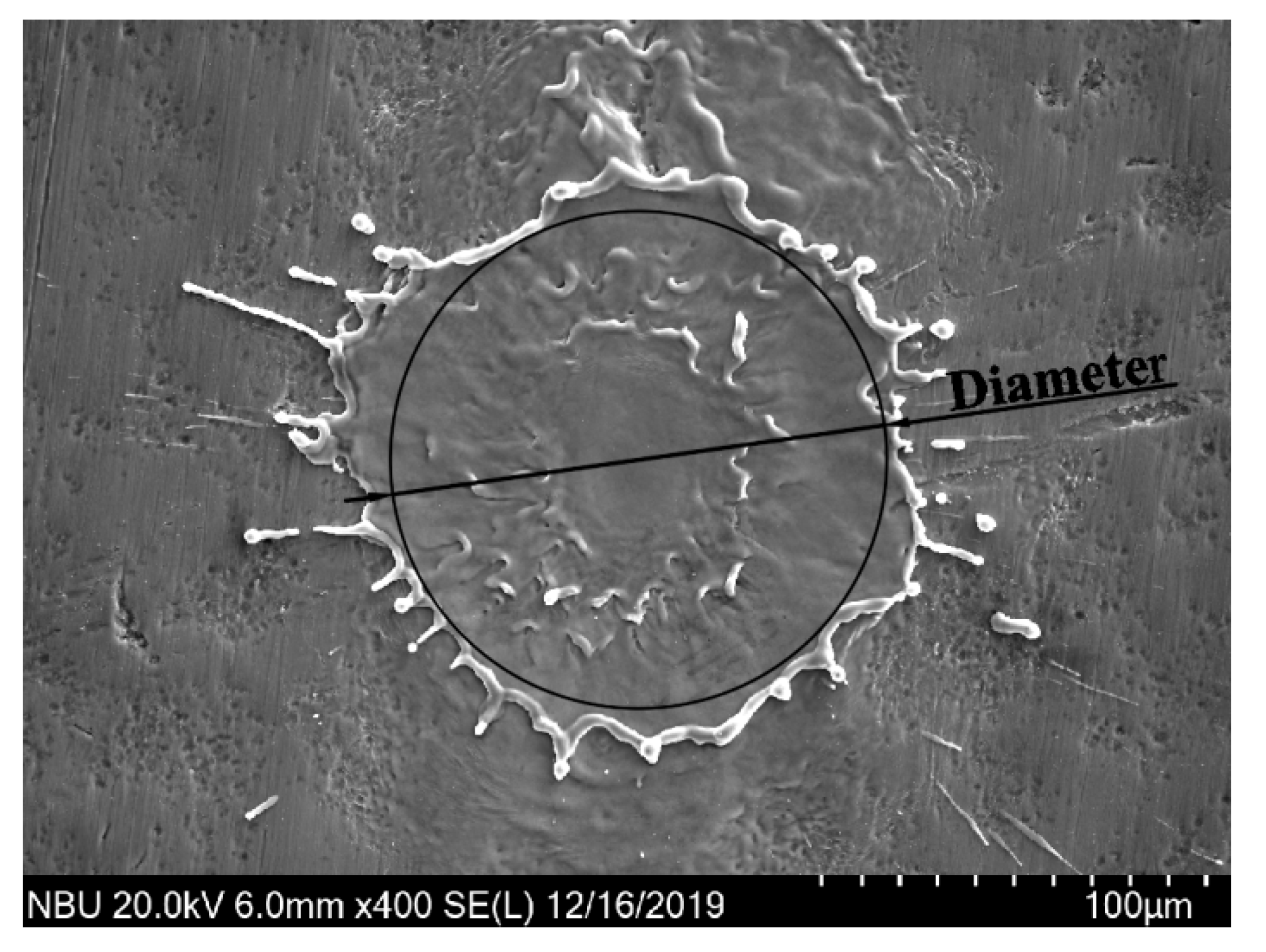

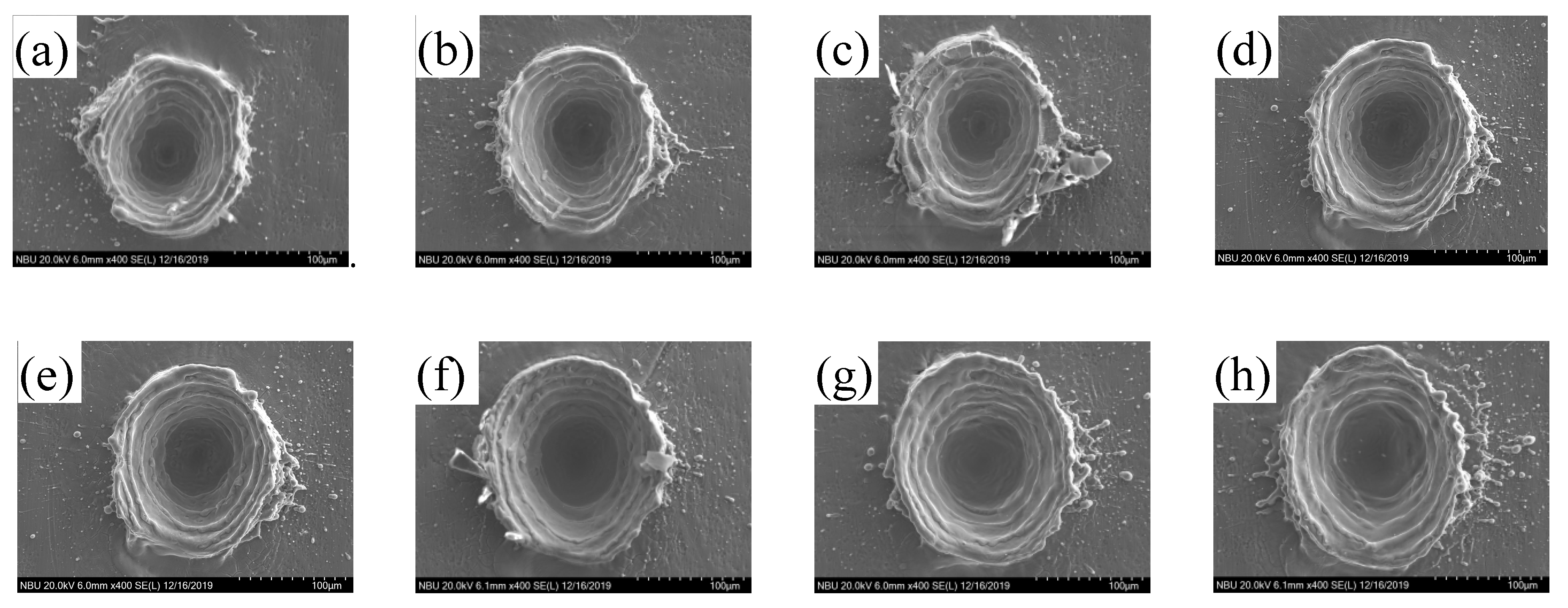
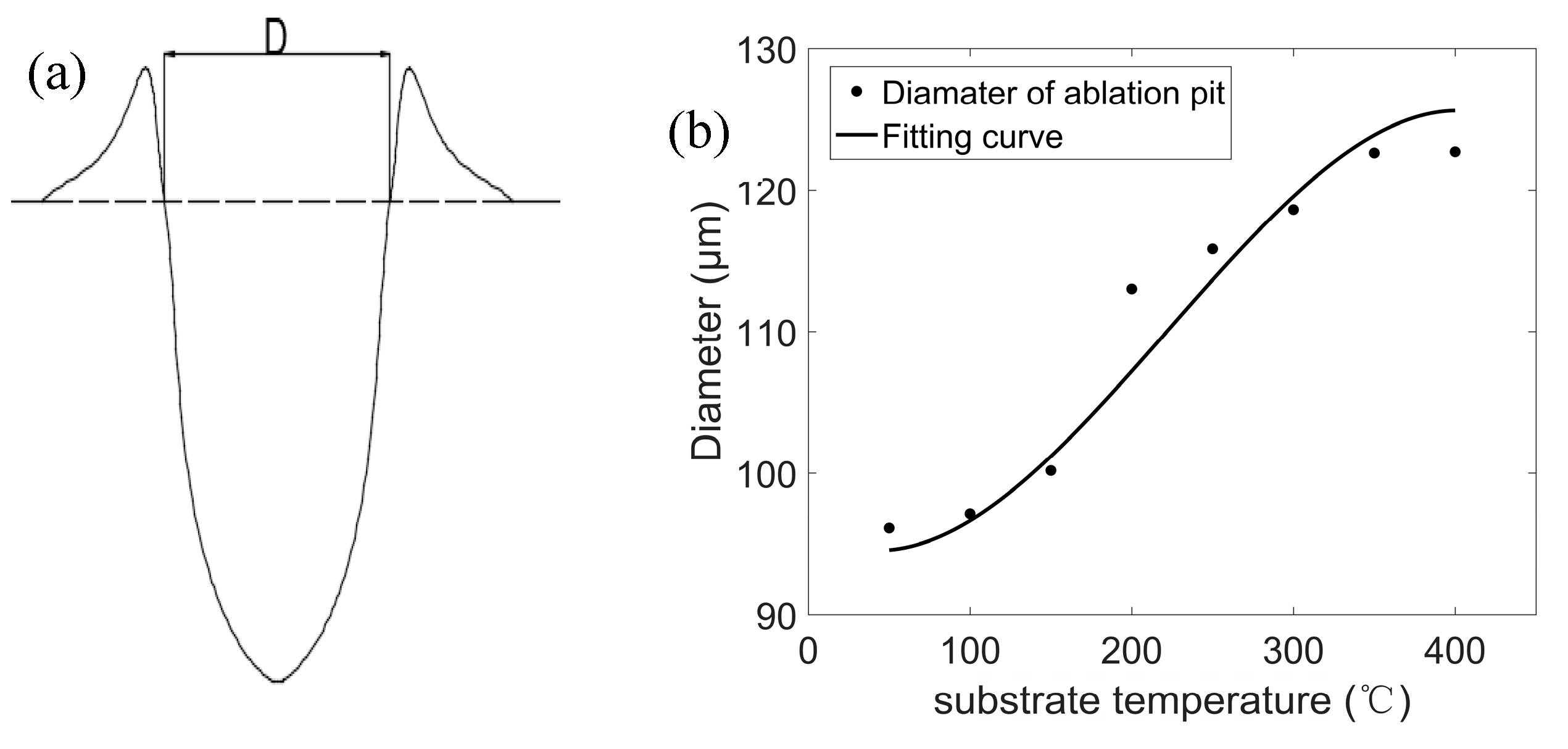
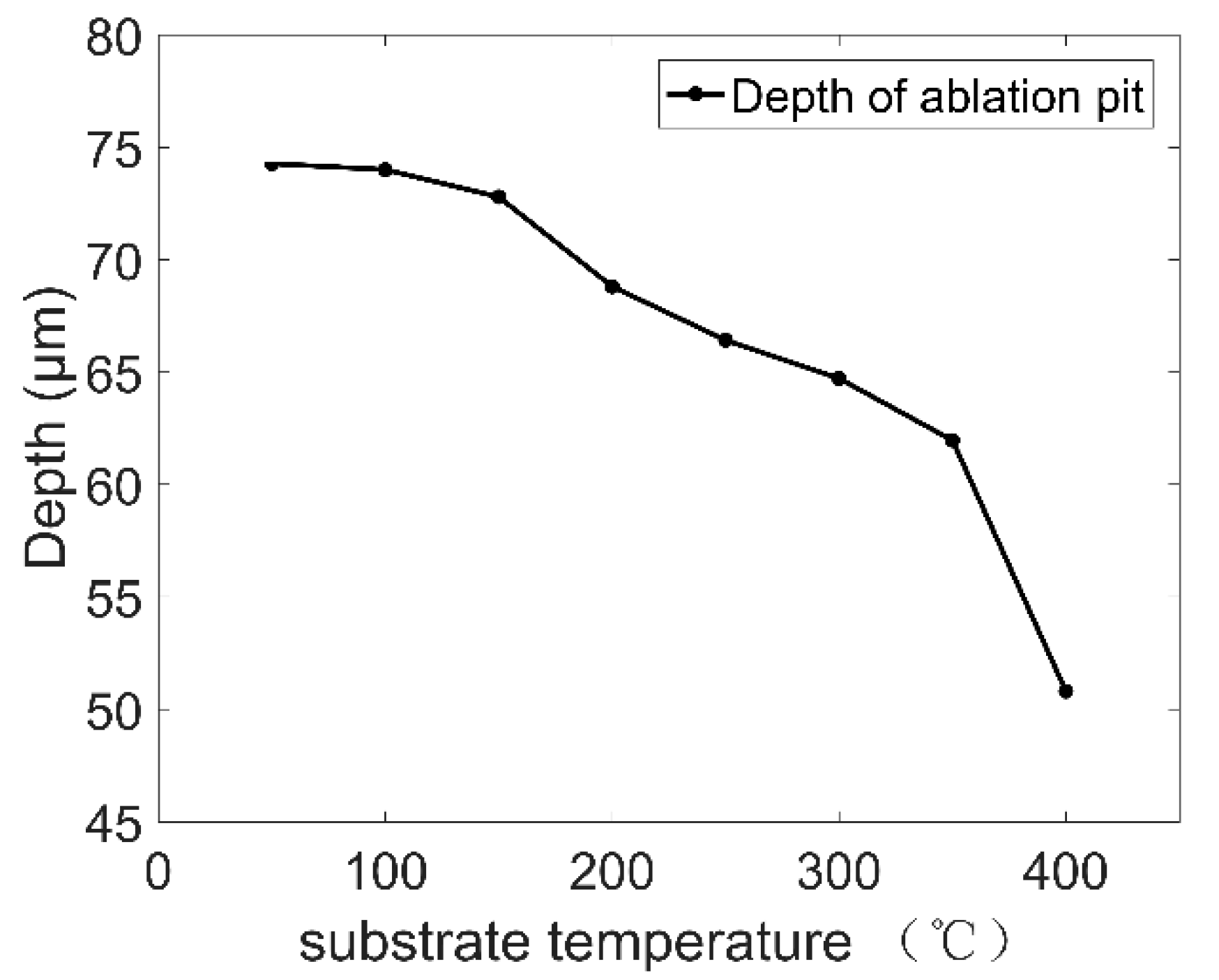
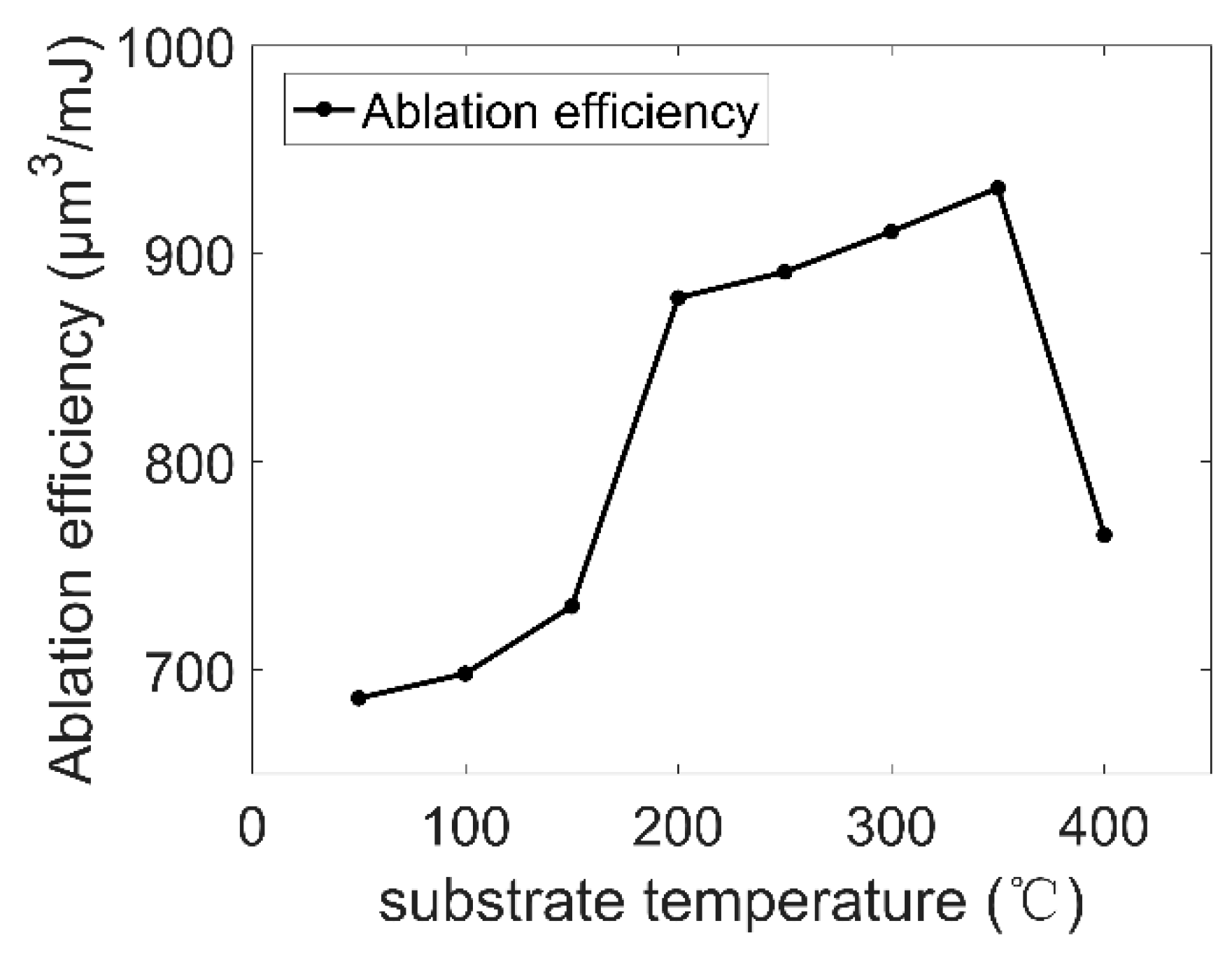
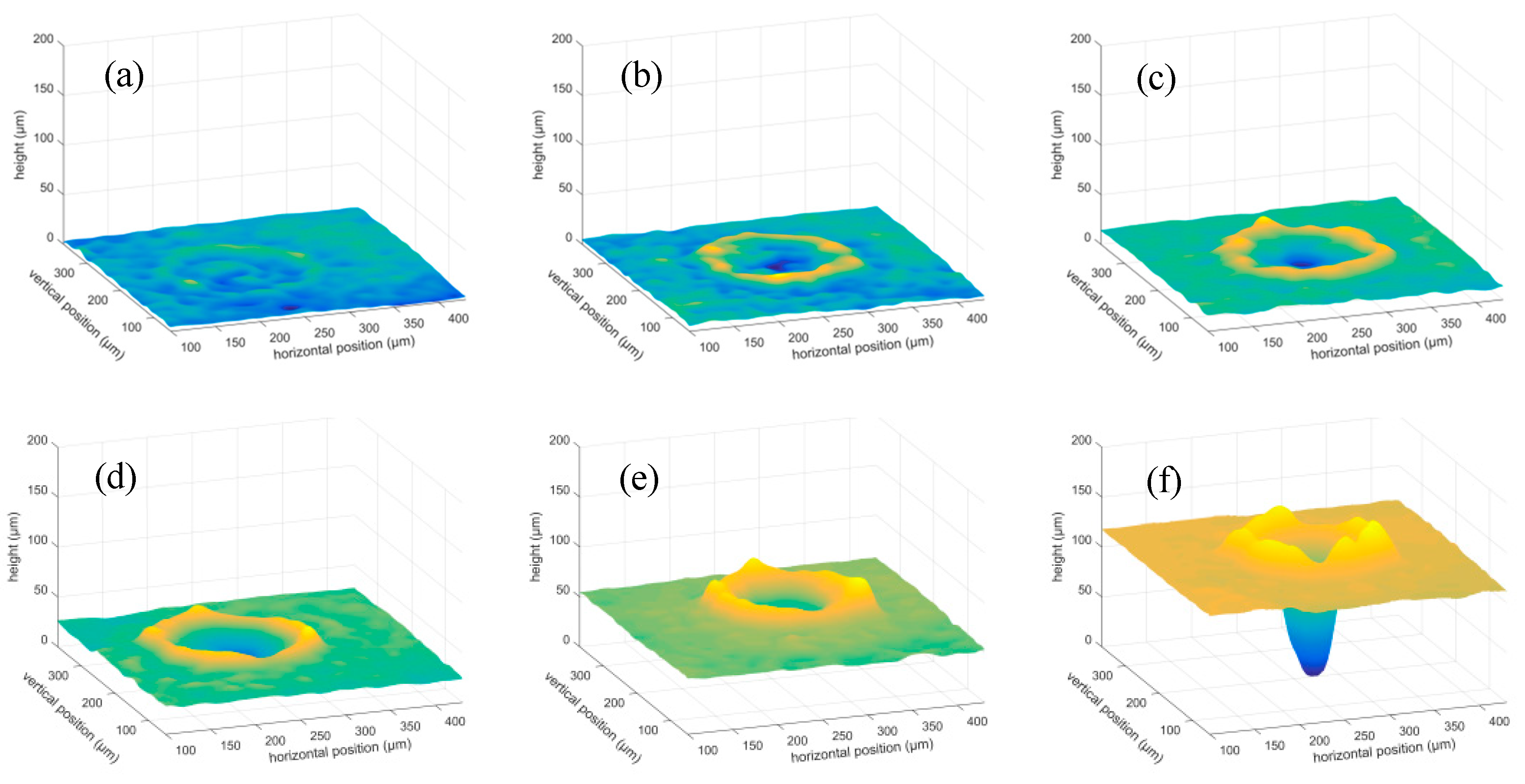
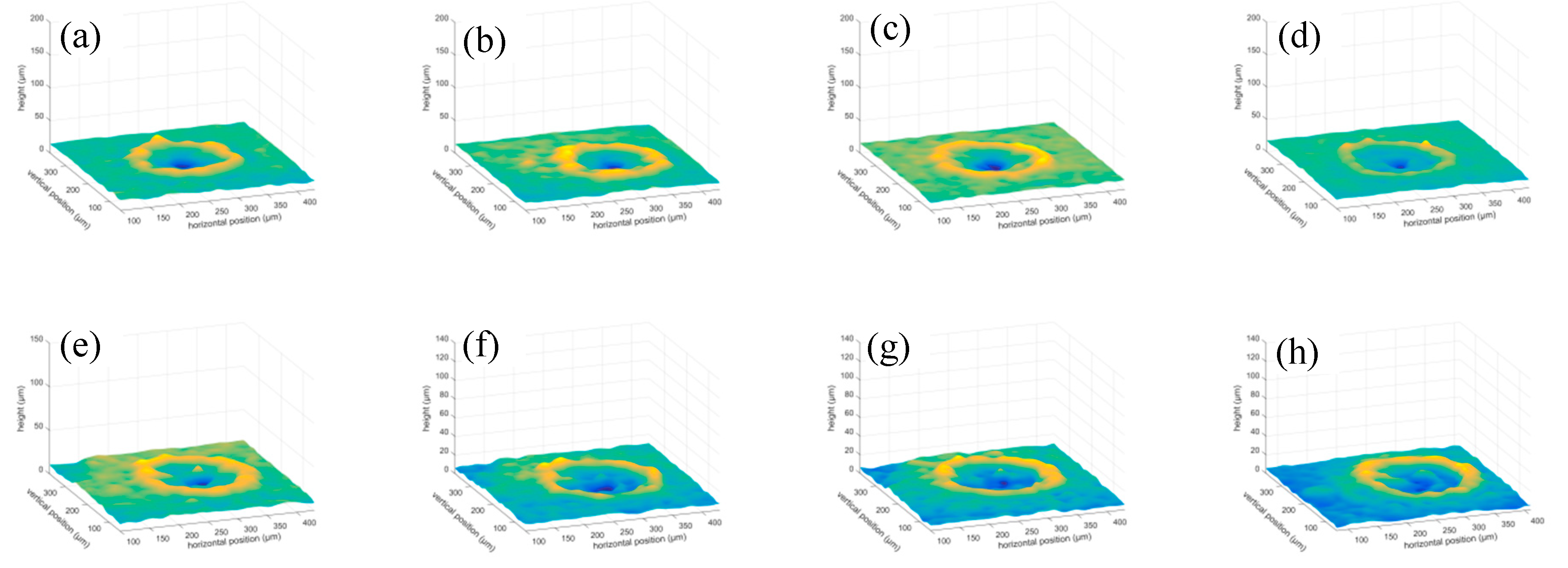
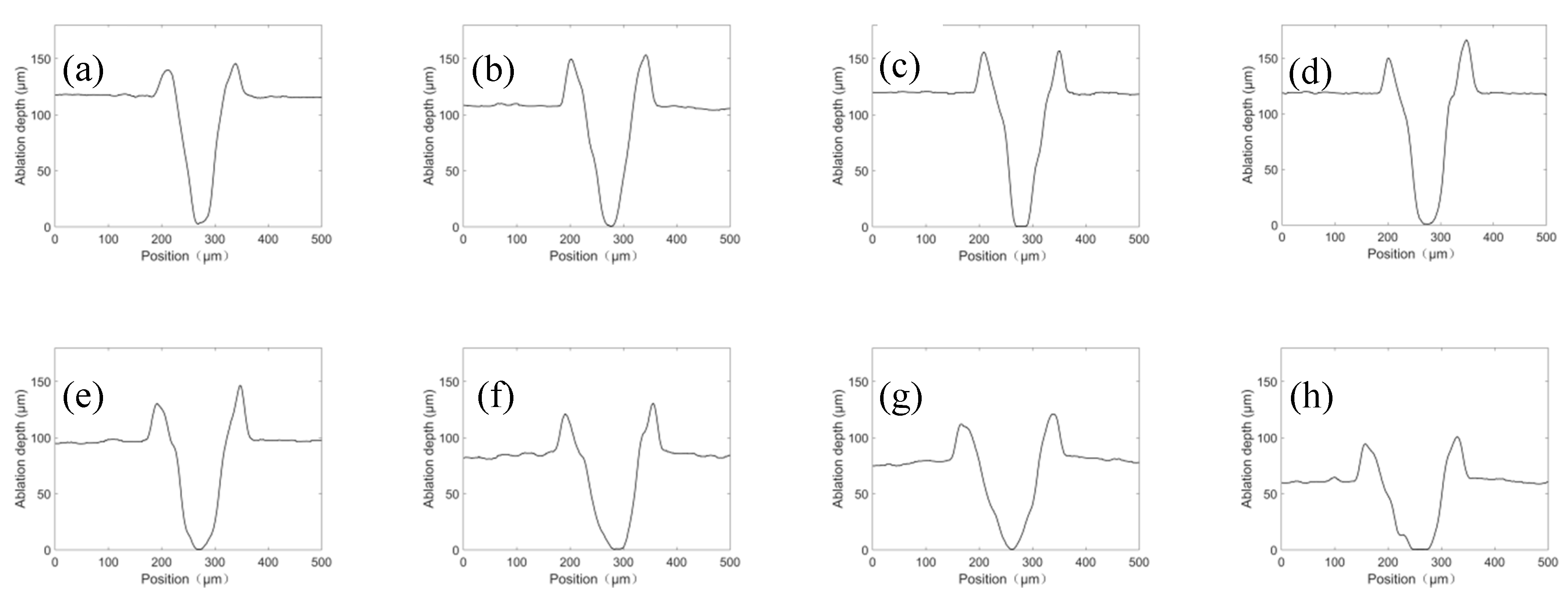
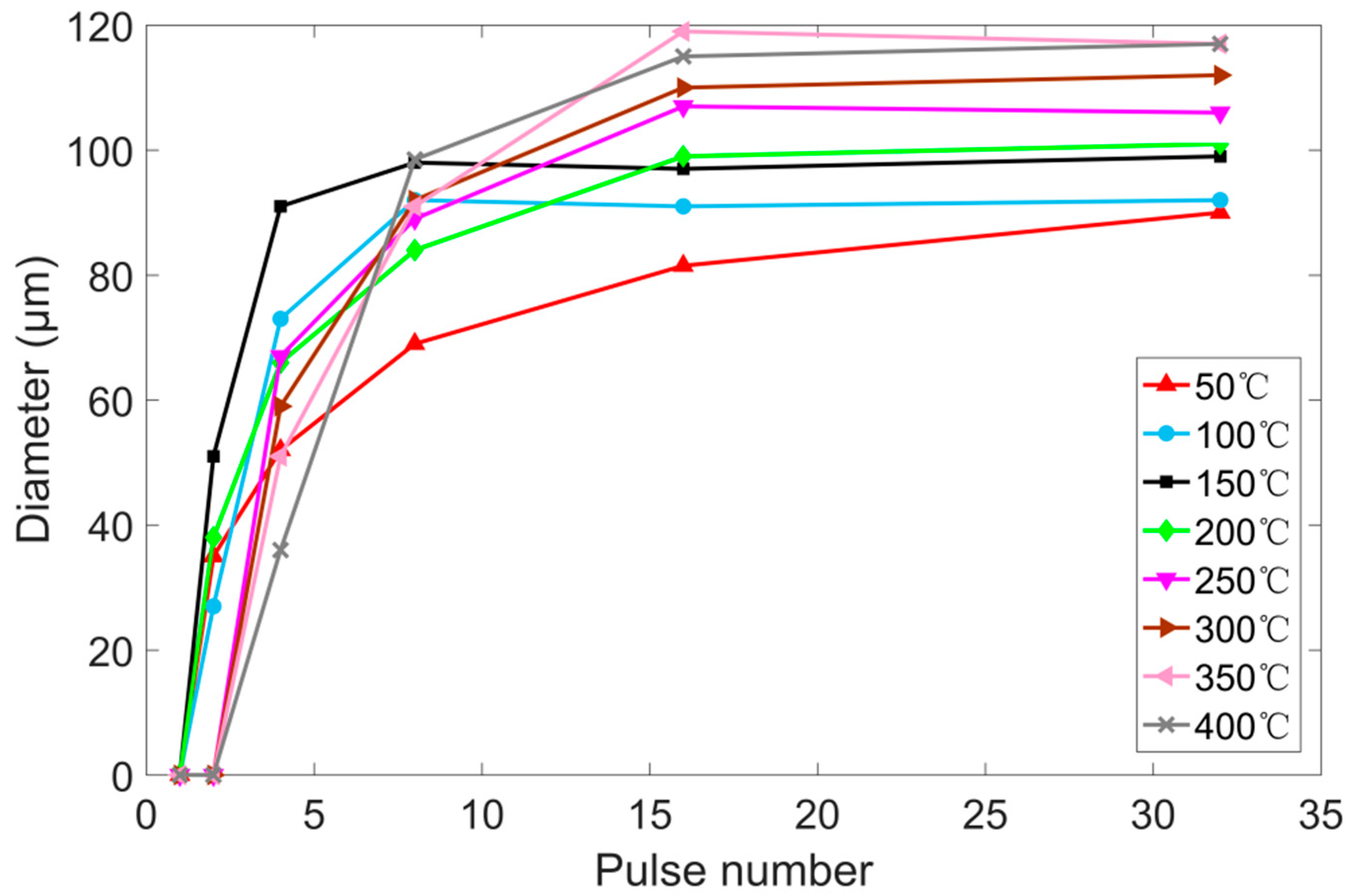
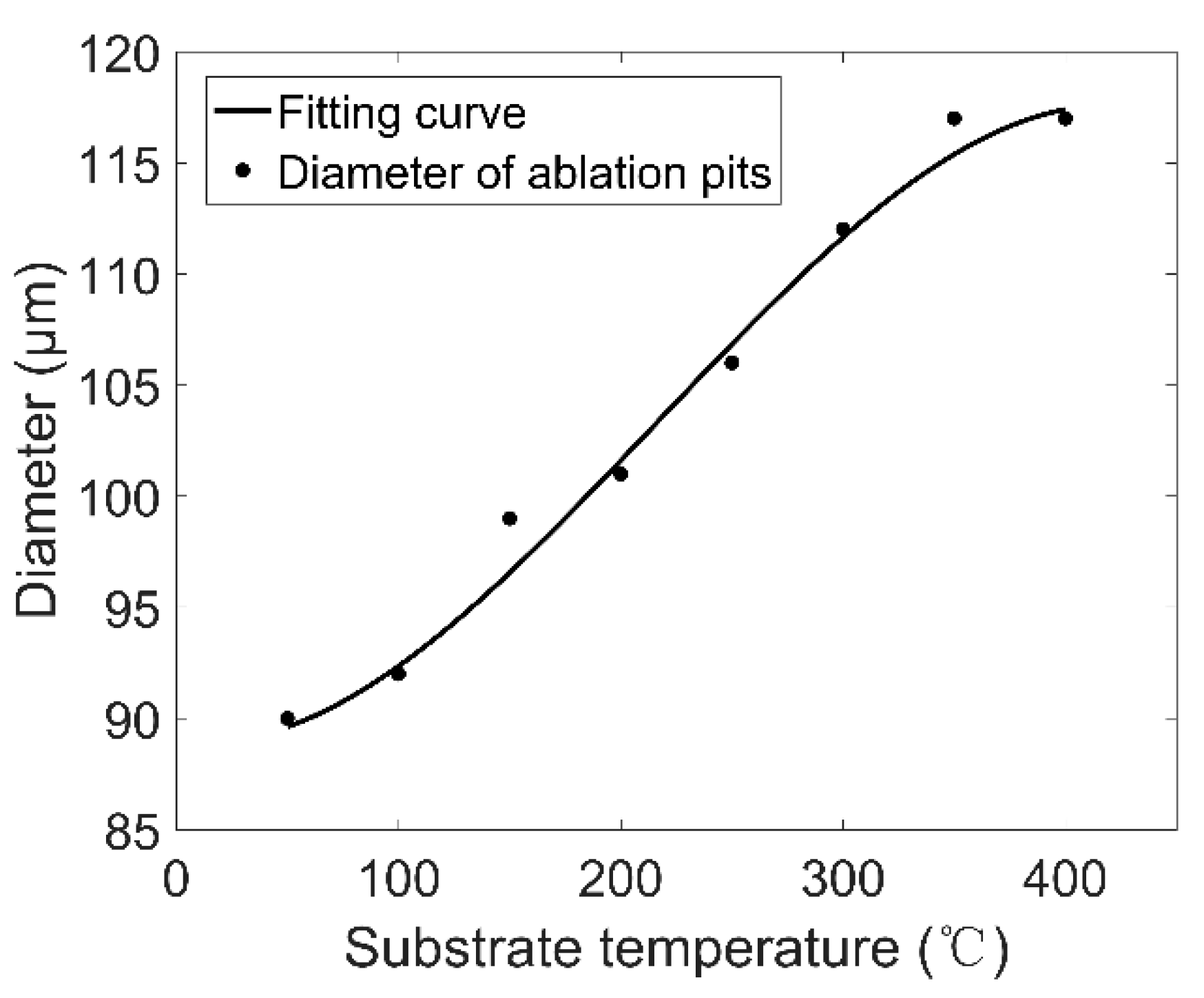
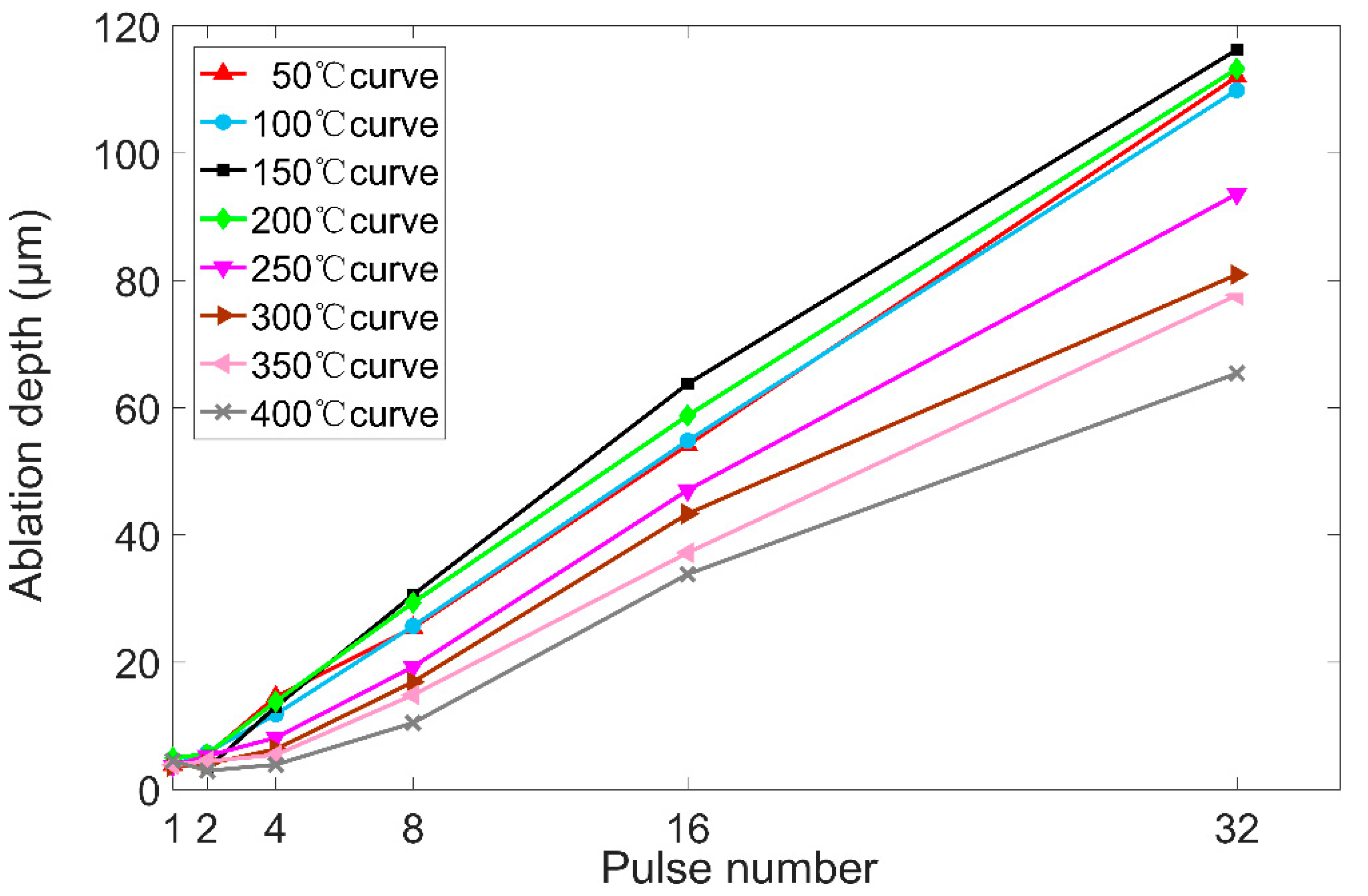
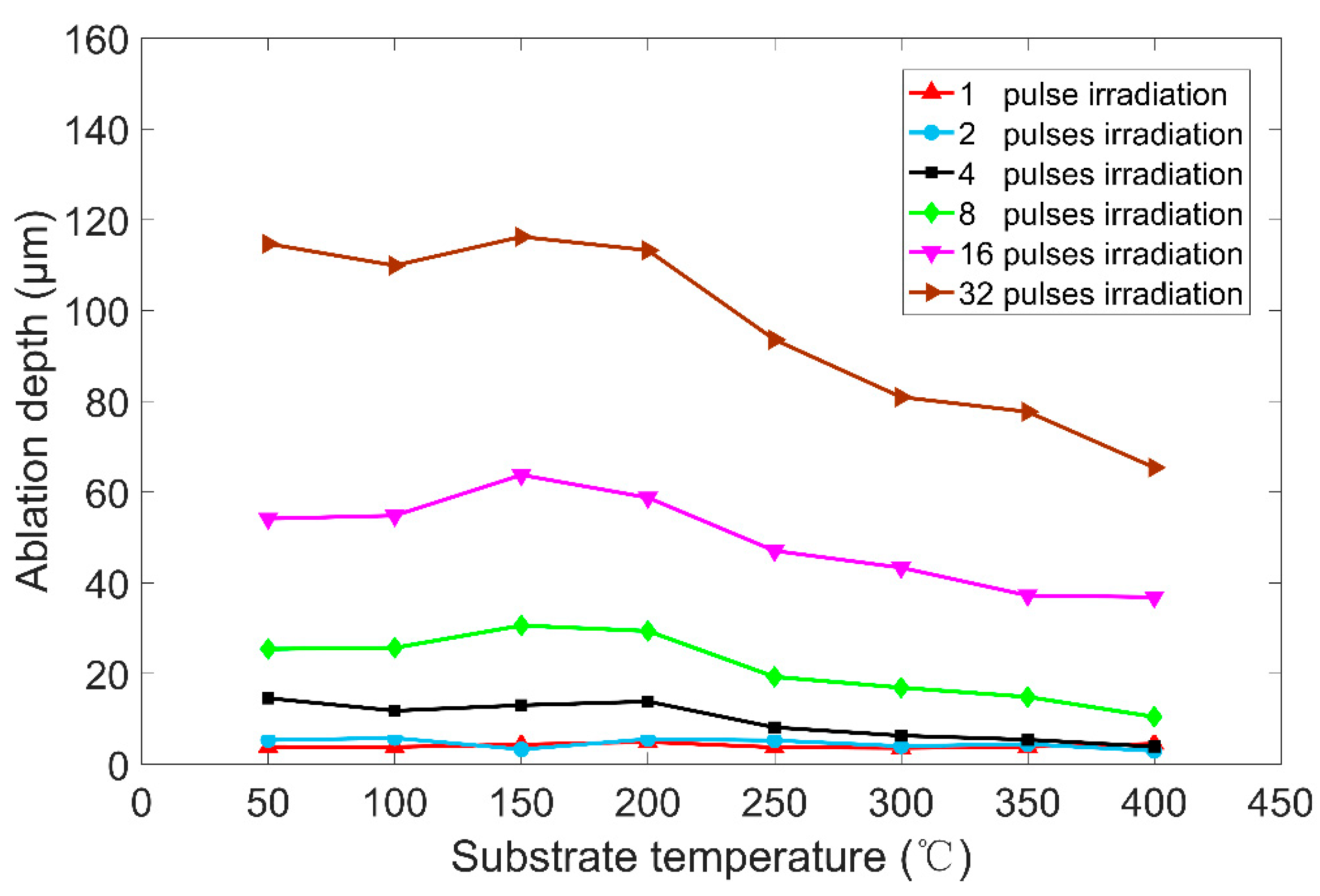
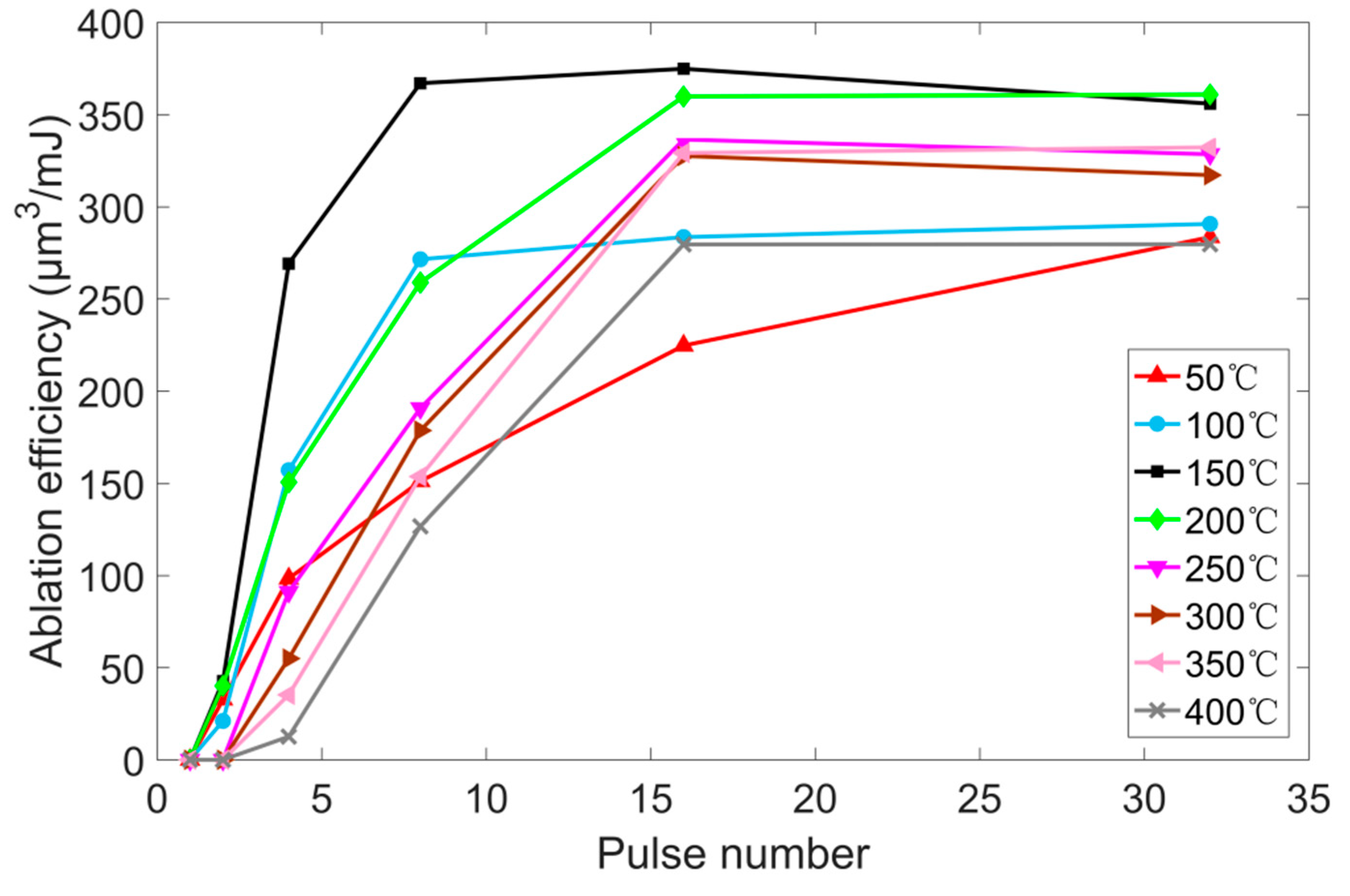
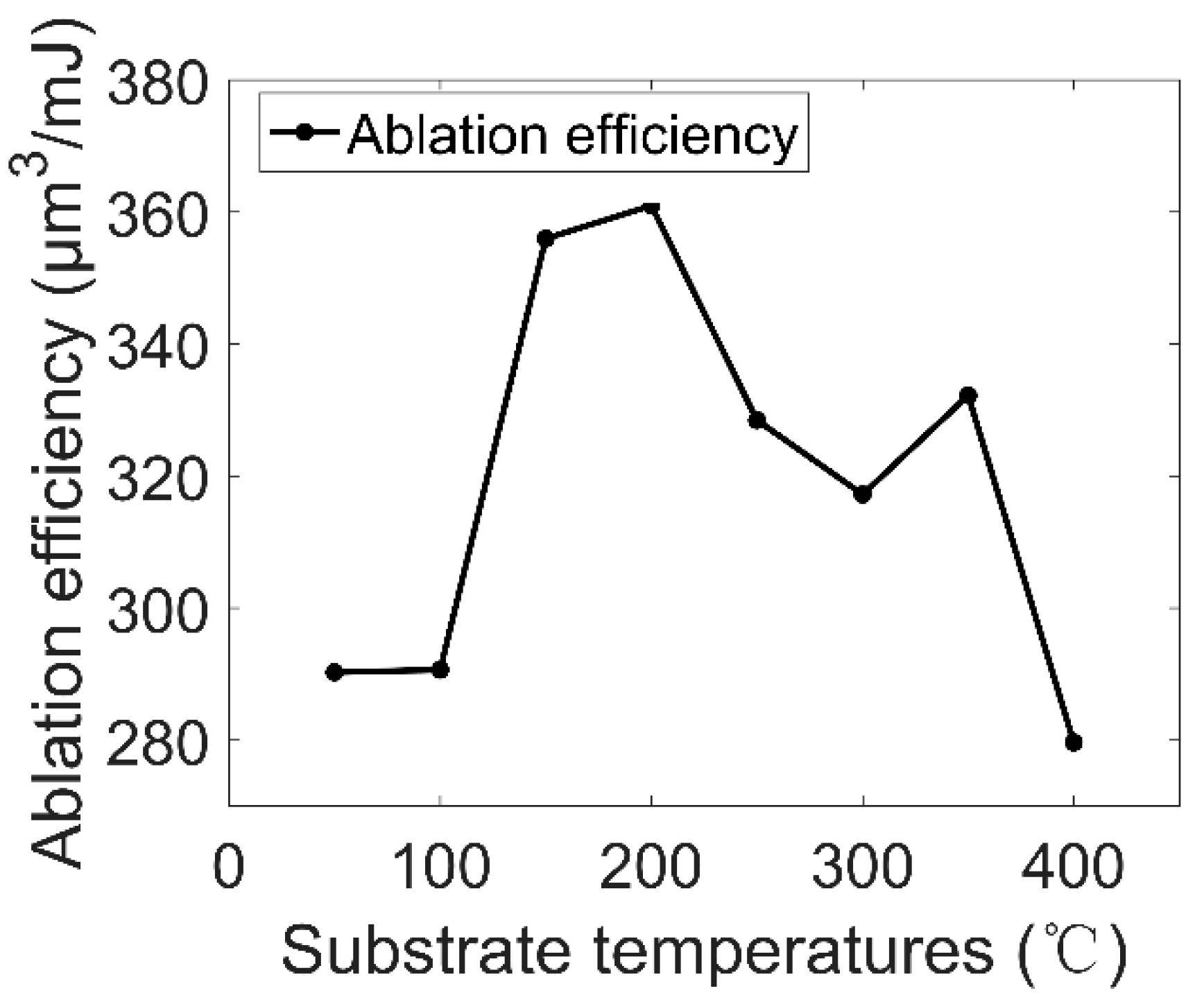
| Element | Fe | Al | V | H | C | O | N | Ti |
|---|---|---|---|---|---|---|---|---|
| Content/% | ≤0.30 | 5.5–6.8 | 3.5–4.5 | ≤0.015 | ≤0.1 | ≤0.20 | ≤0.05 | remainder |
| Experiments | A | B |
|---|---|---|
| Laser type | Continuum Surelite I-10 | |
| Wavelength (nm) | 532 | |
| Repetition rate (Hz) | 10 | |
| Pulse width (ns) | 4–6 | |
| Beam diameter (unfocused) (mm) | 6 | |
| Spot diameter (focused) (μm) | 133.516 | |
| Laser energy (mJ) | 20 | 100 |
| Laser fluence (focused) (μJ/μm2) | 0.1429 | 0.7143 |
| No. | Laser fluence (μJ/μm2) | Pulse Number | Depth (μm) | Diameter (μm) | ω (μm3/mJ) |
|---|---|---|---|---|---|
| 1 | 0.7143 | 1 | 3.83 | 0 | 0 |
| 2 | 2 | 5.33 | 35 | 25.64 | |
| 3 | 4 | 14.55 | 52 | 77.25 | |
| 4 | 8 | 25.40 | 69 | 118.72 | |
| 5 | 16 | 54.12 | 81.5 | 176.46 | |
| 6 | 32 | 112 | 90 | 222.66 |
© 2020 by the authors. Licensee MDPI, Basel, Switzerland. This article is an open access article distributed under the terms and conditions of the Creative Commons Attribution (CC BY) license (http://creativecommons.org/licenses/by/4.0/).
Share and Cite
Zhao, J.; Zhu, Z.; Xu, Y.; Song, X.; Wang, Y.; Peng, H.; Wang, Y.; Zuo, J.; Shu, X.; Yin, A. Nanosecond Laser Ablation of Ti–6Al–4V under Different Temperature. Appl. Sci. 2020, 10, 4657. https://doi.org/10.3390/app10134657
Zhao J, Zhu Z, Xu Y, Song X, Wang Y, Peng H, Wang Y, Zuo J, Shu X, Yin A. Nanosecond Laser Ablation of Ti–6Al–4V under Different Temperature. Applied Sciences. 2020; 10(13):4657. https://doi.org/10.3390/app10134657
Chicago/Turabian StyleZhao, Jiantao, Zhenge Zhu, Yacheng Xu, Xueyong Song, Yufan Wang, Hao Peng, Ying Wang, Jinrong Zuo, Xuedao Shu, and Anmin Yin. 2020. "Nanosecond Laser Ablation of Ti–6Al–4V under Different Temperature" Applied Sciences 10, no. 13: 4657. https://doi.org/10.3390/app10134657






